Sizing Up Servers: Intel's Skylake-SP Xeon versus AMD's EPYC 7000 - The Server CPU Battle of the Decade?
by Johan De Gelas & Ian Cutress on July 11, 2017 12:15 PM EST- Posted in
- CPUs
- AMD
- Intel
- Xeon
- Enterprise
- Skylake
- Zen
- Naples
- Skylake-SP
- EPYC
Intel Expanding the Chipset: 10 Gigabit Ethernet and QuickAssist Technology
The refresh strategy from Intel on the chipset side has an ultra-long cadence. In recent memory, Intel’s platform launches are designed to support two generations of processor release, and in that time there is typically no chipset update, leaving the platform controller hub semi-static for functionality for usually three years. This is compared to the consumer side, where new chipsets are launched with every new CPU generation, with bigger jumps coming every couple of years. For the new launch today, Intel pushing the enterprise chipset ahead in a new direction.
The point of the chipset previously was to provide some basic IO support in the form of SATA/SAS ports, some USB ports, and a few PCIe lanes for simple controllers like USB 3.0, Gigabit Ethernet, or perhaps an x4 PCIe slot for a non-accelerator type card. The new chipsets, part of the C620 family codenamed Lewisburg, are designed to assist with networking, cryptography, and act more like a PCIe switch with up to 20 PCIe 3.0 lane support.
The headline features that matter most is the upgrade in DMI connection to the chipset, upgraded from DMI 2.0 to DMI 3.0 to match the consumer platforms, having those 20 PCIe 3.0 lanes from the chipset, and also the new feature under CPU Uplink.
For the new generation of Lewisburg chipsets, if an OEM requires that a platform has access to a cryptography engine or 10 Gigabit Ethernet, then they can attach 8 or 16 lanes from the processor into the chipset via this CPU Uplink port. Depending on which model of chipset is being used, this can provide up to four 10 GbE ports with iWARP RDMA, or up to 100 GB/s IPSec/SSL of QuickAssist support.
Intel will offer seven different versions of the chipset, varying in 10G and QAT support, but also varying in TDP:
On the cryptography side, Intel has previously sold add-in PCIe cards for QuickAssist, but is now moving it onto the systems directly. By adding it into the chipset, it can be paired with the Ethernet traffic and done in-situ, and specifically Intel points to bulk cryptography (150 Gb/s AES256/SHA256), Public Key Encryption (100k ops of RSA2048) and compression (100+ Gb/s deflate).
With the GbE, Intel has designed this to be paired with the X722 PHY, and supports network virtualization, traffic shaping, and supports Intel’s Data Plane Development Kit for advanced packet forwarding.
The chipset will also include a new feature called Intel’s Innovation Engine, giving a small embedded core into the PCH which mirrors Intel’s Management Engine but is designed for system-builders and integrators. This allows specialist firmware to manage some of the capabilities of the system on top of Intel’s ME, and is essentially an Intel Quark x86 core with 1.4MB SRAM.
The chipsets are also designed to be supported between different CPUs within the same multi-processor system, or for a system to support multiple chipsets at once as needed.


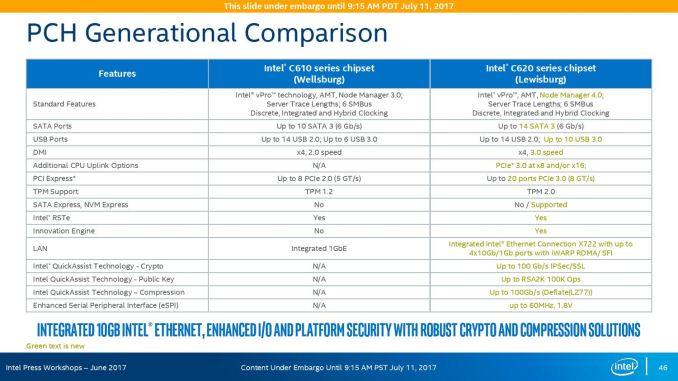
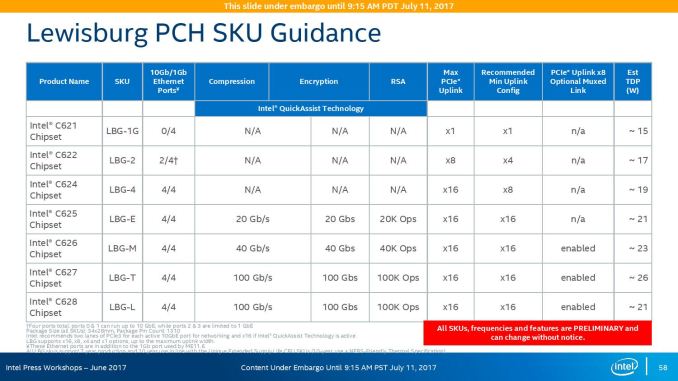
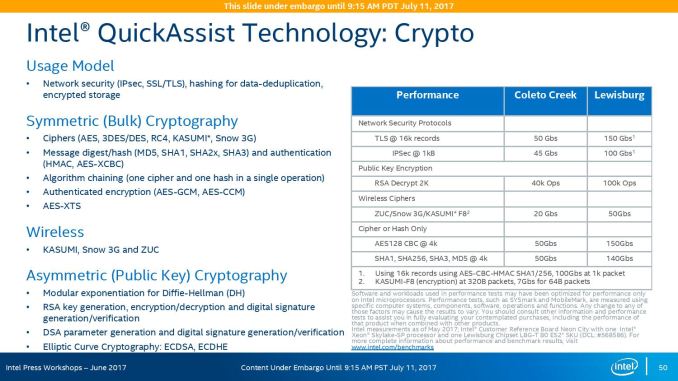

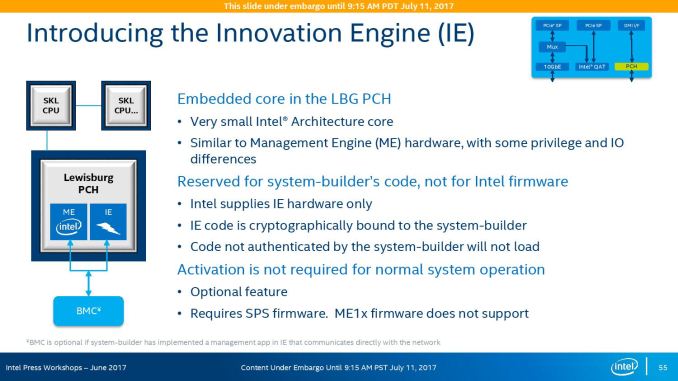
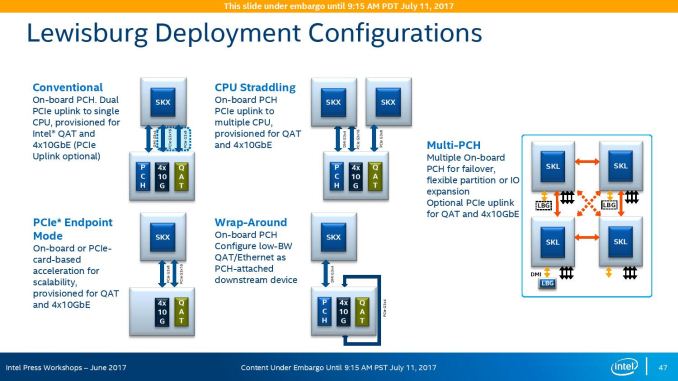








219 Comments
View All Comments
Kaotika - Tuesday, July 11, 2017 - link
http://www.anandtech.com/show/11464/intel-announce...This one remains wrong though
Ian Cutress - Tuesday, July 11, 2017 - link
Always reference the newest piece, especially the main review.Or we'd spend half of our time going back and updating old pieces and reviews with new data.
scottb9239 - Tuesday, July 11, 2017 - link
On the POV-RAY benchmark, shouldn't that read as almost 16% faster than the dual 2699 v4 and 32% faster than the dual 8176?scienceomatica - Tuesday, July 11, 2017 - link
I think that a fair game would be to compare the top offer of one and the other manufacturer, in other words, the Xeon 8180 should be included in the benchmark regardless of the aspect of the price. Then the difference would be quite in favor of the Intel processor, although it has few cores less.Tamz_msc - Tuesday, July 11, 2017 - link
Will we get to see more FP HPC-oriented workloads like SPECfp2006 or even 2017 being discussed in a future article?lefty2 - Tuesday, July 11, 2017 - link
I can summarize this article: "$8719 chip beaten by $4200 chip in everything except database and Appache spark."Well done Intel, another Walletripper!
Shankar1962 - Wednesday, July 12, 2017 - link
Then why did google att aws etc upgraded to skylake. They could have saved billions of dollars.Shankar1962 - Wednesday, July 12, 2017 - link
Look at what big players upgrading to skylake reportedThese are real workloads
No one cares about labs
These numbers decide who wins and who loses
No wonder AMD sells at $4200
https://www.google.com/amp/s/seekingalpha.com/amp/...
nitrobg - Tuesday, July 11, 2017 - link
Pricing on page 10 should reflect that the 2P EPYC prices are for 2 processors, not per CPU. The price of Xeons is per CPU.coder543 - Tuesday, July 11, 2017 - link
That doesn't seem true. The prices they currently have seem to be correct. Got a source?